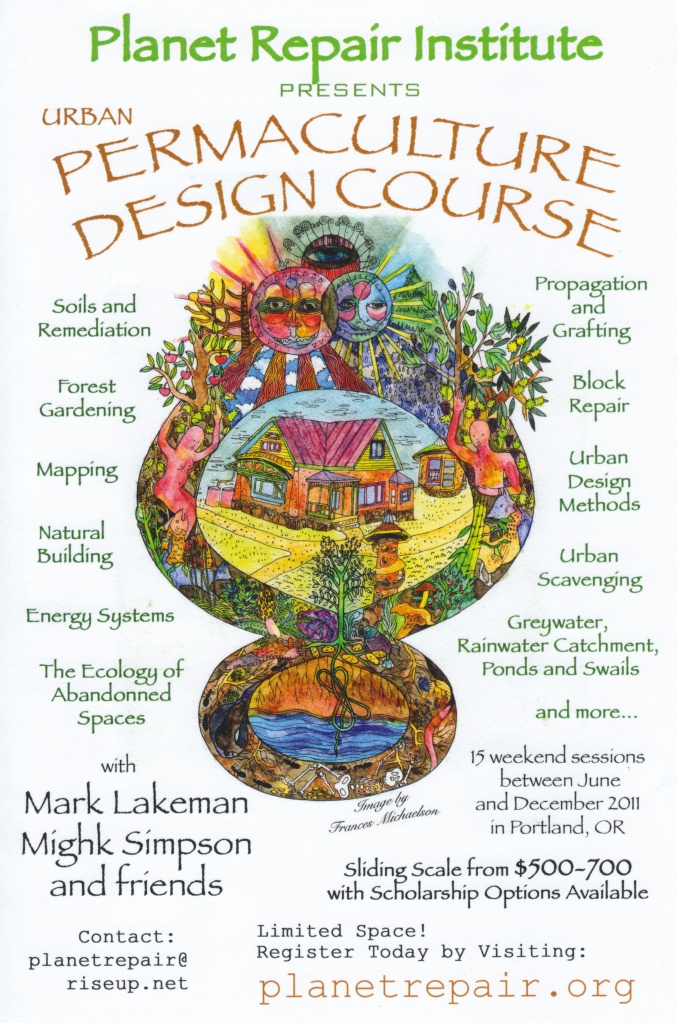Planet Repair Institute (PRI) http://www.planetrepair.org
(Though activity is ongoing, this website is not frequently maintained)
Initiated in 1996, formalized in 2010 – The ongoing project has been co-organized by Mark Lakeman, Sarah Frances Michaelson, Sarah Heath, Mighk Simpson. Original version of this initiative was configured by Pedro Ferbel-Azcarate with Adriana Azcarate-Ferbel, Jenn Rawling, Trillium Shannon, and Kayleen Chasse.
PRI is an prototype for global transformation through local, place based action. It is an utterly transformed single family home embedded in a typical socially isolated neighborhood within the colonial grid. PRI is comprised of several retrofit and new natural buildings using light straw clay, cob, and various kinds of natural finishes including earthen plasters. The site also features numerous energy efficient and water-related permaculture systems, as well as productive gardens. Planet Repair is also widely known as the birthplace of the first generation of City Repair and it’s many prototype projects. You can see all of these via an online search. They include:
- The T-Hows community gathering project.
- The Intersection Repair Project, for the legal transition of street right of way crossroads into community gathering places (as happens planet-wide in the context of non-dominated settlement patterns).
- T-Horse, the most popular “transformer” vehicle in Portland, a mobile public square actually built onto a 1995 Mazda truck. Shaped like gigantic butterfly wings, the bamboo canopies and translucent kitchen canopy provide shelter for pie and cake-based ephemeral gatherings that can occur anywhere, anytime, but especially the roads, parking lots, and parks of Portland, Oregon.
- The Village Building Convergence is a 10-day urban permaculture, place based building festival. This enormous transformational initiative that has been focused as much on shifting political and bureaucratic cultures as it has been to build an alternative spectrum of socially equitable and ecologically sustainable infrastructure. Chief among these has been the goal of building at least one community gathering place in every neighborhood of Portland, in order to inspire a total of 1500 to 3000 in Portland alone. The first VBC project is located at this site. For more information, please see http://www.villagebuildingconvergence.com.
- communitecture, architecture & planning the radical design collaborative also began at this location. It originally emerged as a collection of designers and architects who had been attracted to volunteer with City Repair. It soon became apparent that creative design was a strength of City Repair, and for various reasons the designers chose to become a distinct entity focused on a wide spectrum of design projects. Please see http://www.communitecture.net
- BLOCK REPAIR, centered at PRI is an ongoing project to inspire the whole transformation of a typical American neighborhood into a sustainable and just model that will inspire all others in Portland and beyond.
- City Repair’s Urban Permaculture Design Course (UPDC) originally began at PRI. Unlike conventional permaculture curriculum, in this course place making is used as an armature for permaculture design in the urban context. With all design projects developed in the service of actual clients in need, the UPDC has a very strong social justice. In fact, the course is generally given credit for having supported the timely emergence of the concept of “social permaculture”. For more on the UPDC please see https://cityrepair.org/updc.
The image below depicts a promo poster for the first UPDC taught in 2011.

